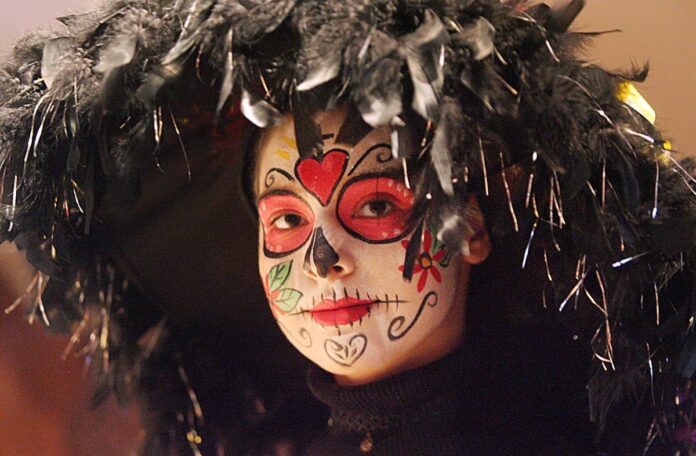EDINBURG — Despite the cemetery on display at the Museum of South Texas History and dozens of people walking around as calaveras, or skeletons, the mood Saturday was far from creepy.
A mariachi playing here, some dancers spinning to folkorico there, and the museum’s 13th annual Dia de los Muertos celebration was underway. Inside and out, the museum was filled with people snacking on sugar skulls, studying altars or browsing artisan jewelry and décor.
The 11 altars on display each honored a different person who has died, filling the room with a somber silence. One was dedicated to Tejano singer Selena and another to cyclists everywhere who were killed while riding. A third altar honored former University of Texas – Pan American art professor Richard Hyslin, who succumbed to cancer in May. His display, created by art students from Elias Longoria Middle School, was the tallest in the room, nearly reaching the ceiling.
Those honorary shrines are among the many things that make the event unique, according to Rene Ballesteros, MOSTHistory’s programs and events officer.
“This, more than anything, shares our culture, our heritage and our history. That is our mission here at the museum — to preserve and present that,” he said. “Big events like this are definitely a medium for people to tell their stories. More than anything, that’s what people do here.”
The cemetery at the back of the building was another way visitors could mourn or honor those they have lost. Ballesteros said this was the feature’s premiere and would also serve as a stage for local actor Pedro Garcia, who performed a one-man play in the evening.
Various mariachis and dance groups entertained guests from sun up until sundown. Local singer Beatriz Gonzalez was among them as a headliner. Each group and every artist was featured to add to the event’s purpose, according to Ballesteros.
“I think it gives an opportunity for the community to show their talents, like the music, the altars, so they can tell their stories,” he said. “And it also provides an event that is pretty authentic.”
If authenticity was the goal, Mission resident Diana Flores confirmed MOSTHistory hit it out of the park.
“Everything here is really great, to tell the truth,” Flores said in Spanish. “I would have never thought that an event here would feature so much familiarity with Mexican culture.”
That was not the only thing that pleased Flores, who came to the Rio Grande Valley from Monterrey eight years ago.
“It surprises me that there is such variety in food and merchandise here,” she said. “And the fact that so many people from around here who are not Mexican — anglos — are here, showing interest in Mexican culture. It’s a great thing.”
Her 12-year-old daughter stood shyly by her mother’s side. St. John’s Episcopal School in McAllen, where the girl is a student, encouraged families to attend the Day of the Dead celebration. Flores expressed gratitude for the heads up because, as she explained, it served as much more than a fun day out.
“This will teach her all kinds of things that she has never seen before. She’s never seen Day of the Dead being celebrated like this or what the catrinas walking around here look like in person,” she said, referring to the various women sporting painted skull faces and classy dresses with large, feathered hats.
Before immigrating to the RGV, Flores said she celebrated Day of the Dead often. But since coming here, that is rarely the case. Ballesteros said one of his motivators for continuing the museum’s annual event is to foster traditions like those locally.
“It’s Dia de los Muertos and, more than anything, it’s like an educational event because this tradition has really been brought from southern Mexico,” he said. “It’s been growing here rapidly over the past few years mostly because of immigration, a change of ideas, and we’re a really unique culture here.”




